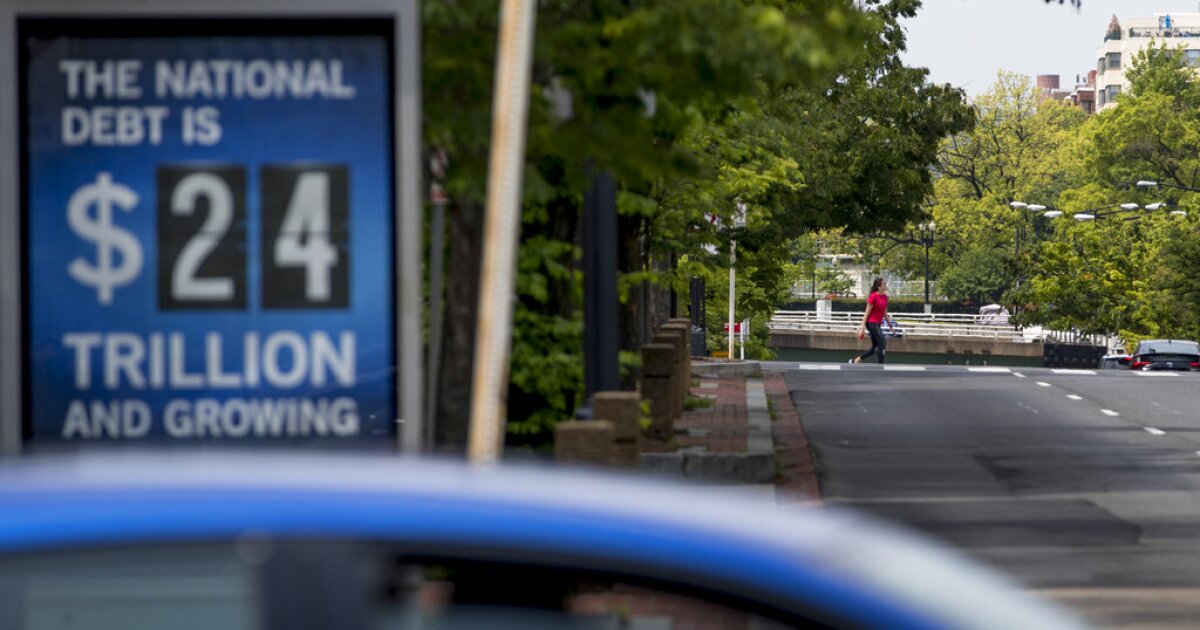

Fueled by the pandemic and years of fiscal splurging, the national debt of the United States blew past a record-shattering $31 trillion in October, and the country is barreling toward a future economic reckoning.
Economists have long debated the precise repercussions of skyrocketing debt, with some downplaying fears of a cataclysmic crisis and most others quibbling about whether its ramifications will take the shape of a slow-moving economic demise or eventually reach a breaking point.
SOARING INTEREST RATES MEAN DEBT RECKONING COULD COME YEARS SOONER THAN THOUGHT
“This is totally uncharted territory. These are debt levels that have not been seen before. This is going to exceed even Japan’s debt, which is the largest debt as a share of the economy in the entire industrialized world,” Brian Riedl, a senior fellow at the Manhattan Institute, told the Washington Examiner.
Already, the U.S. debt-to-GDP ratio has ballooned to the highest levels since the end of World War II. The latest annual deficit for fiscal 2022 was $1.38 trillion, per the Treasury. As trillion-dollar annual deficits become the norm in Washington, the U.S. is already hovering around a 120% debt-to-GDP ratio, all while the population begins to age rapidly.
Here is a look at some of the ramifications economists believe the U.S. could face due to the spiraling national debt.
Default
Although economists generally see defaulting on the debt as unlikely due to the U.S. control of the dollar and its ability to borrow from its own currency, the country could simply stop meeting its debt obligations at some point in the future if the debt becomes out of control.
In that scenario, investors could get spooked from injecting capital into U.S. businesses, and interest rates would very likely soar on the debt. This would mean inflation and a recession or depression.
Unlike previous economic downturns, the government may not be able to lean on deficit spending to steer out of such a rut due to a more difficult landscape for borrowing amid blemished credit.
Inflationary crisis
To avert a default or sharp tax increase and deep spending cuts, the government could tap into monetary policy and engage in so-called money printing, which risks inflation.
“There’s no reason for us to default because we can always print more money, so I think the bigger risk is high levels of inflation,” Maya MacGuineas, the president of the bipartisan Committee for a Responsible Federal Budget, told the Washington Examiner.
America is presently in the middle of an inflationary bout stemming from the pandemic. But what could make a future debt-induced inflationary spiral particularly precarious is that the remedy the Federal Reserve generally pursues to tame inflation, monetary tightening and higher interest on reserve balances rates, would likely spike interest rates on the national debt. In other words, the U.S. may be forced to choose between financing its debt or conquering inflation.
Painful austerity measures
Faced between inflation and default, the government could opt for a third option of making dramatic cuts to the federal budget or massive tax hikes, which risk damaging the economy. Much of the government spending in the future is projected to be on entitlement programs such as Social Security and Medicare, both of which are heading toward insolvency.
“The real danger is if they wait 10 or 15 years, seeing the debt really grow to an uncontrollable level, and then have to do drastic and brutal tax increases and spending cuts that will cause a lot more pain,” Riedl said. “If they do it now and do it right, I think that the economic pain can be minimized.”
Lack of fiscal space
Future economic crises can crop up out of nowhere. The COVID-19 pandemic caught the world off-guard in 2020 and led to gargantuan spending deficits from the U.S. and other nations. But in the future, the U.S. may struggle under a large debt load to borrow at needed levels without exacerbating its economic woes.
“One of the reasons you want to have fiscal space and so that you can borrow when you need to, like during the pandemic, but if you borrow when you don’t need to, like now or prior to the pandemic, it leaves you less able to borrow without pushing up interest rates when a real emergency comes along,” MacGuineas said.
In other words, the U.S. could be stranded in prolonged periods of economic turmoil down the line.
Slow decline
Perhaps the most likely consequence of the soaring national debt is a slow decline in the economy over time, according to both Riedl and MacGuineas.
“There’s no one number that when you hit that, you’re at the point of no return. It’s just more of a huge ecosystem with lots of variables affecting it,” MacGuineas said.
One of the main causes of debt-induced decline is the crowding-out effect, in which investment money will pour into servicing the government debt instead of areas of the economy that would lead to a boost in productivity.
Recently, crowding out has not “been dangerously high” due to high levels of private savings, but there has been some crowding out that cooled off economic growth over recent years, MacGuineas said. As the debt continues to grow, this toll will become more evident over time, according to Riedl.
“You do start to see more significant reductions in economic growth because the more savings that are being soaked up by the government to finance its deficit, the less money is available for home loans, car loans, business loans, investments that grow the economy,” Riedl said.
Due to the exploding debt, the gross national product of the economy will fall by $6,000 per capita by 2050 than what it otherwise would have been without high deficits, the Congressional Budget Office estimated before the pandemic.
CLICK HERE TO READ MORE FROM THE WASHINGTON EXAMINER
Interest payments on the debt continue to skyrocket. Out of the roughly $6.27 trillion federal budget for fiscal 2022, interest payments cost $475 billion, above the initial $357 billion projected by the White House, according to the Treasury. In about 30 years, paying off the interest on the debt will account for nearly half of all federal tax revenue, according to the Peterson Institute for International Economics.
Over recent years, the interest rate on the debt has been markedly low, but that could change in the future.
“One reason interest rates have been lower for the last 20 years or so is when baby boomers were in their 40s and 50s, they were saving for retirement, and that increased savings rates and kept interest rates low,” Riedl said. “That reverses itself when they retire.”
To avert a future reckoning on the debt, economists believe that Congress should take steps to reduce the deficit so that the size of the debt falls over time in relation to the economy.





